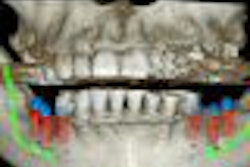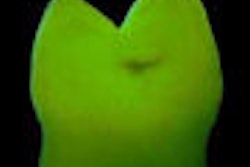
Olympic gymnastics regulations lack teeth -- literally, according to some U.S. dentists. They argue that a panoramic x-ray could show whether Chinese gymnasts are old enough to participate in the competition.
The controversy flared when some observers questioned whether the female Chinese gymnasts participating in the 2008 Olympic Games in Beijing this month were at least 16 years old, a condition for participating in the tournament. News agencies have reported finding Chinese government documents that list the ages of national team members as young as 13.
Some dentists watching the news reports immediately thought of techniques used to estimate age by dentition. "I thought, 'Gee whiz, why we could tell them what their age is, if they'd let us,'" said Peter Hampl, D.D.S., president of the American Board of Forensic Odontology. "It would be a slam dunk."
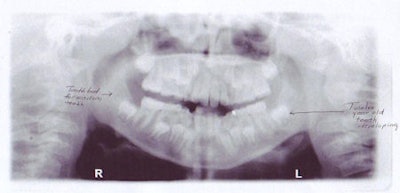 |
| Above, panoramic x-ray of a 9-year-old shows the mixed dentition typical of someone that age. Below, panoramic x-ray of a 16-year-old shows the formation of third molars. All images courtesy of Sandra Swing, D.D.S. |
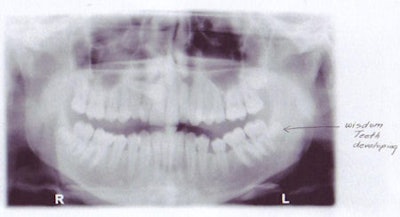 |
The Chinese team won the most gold medals in the female gymnastics competition in the current Olympics. The light weight and flexibility of younger athletes is generally considered an advantage.
The International Olympic Committee (IOC) did not respond to a request for comment from DrBicuspid.com. But the International Gymnastics Federation (which goes by its initials in French: FIG) has issued a statement of confidence in the girls' ages: "The FIG has received confirmation from the International Olympic Committee that all passports are valid for all gymnasts competing in the Beijing Olympic Games. Stringent control measures are taken at the time of athlete accreditation for all official FIG competitions. Further, all athlete ages for the Beijing Olympic Games are consistent with the FIG records for all past FIG competitions."
That statement hasn't convinced everyone, however. The official Beijing Olympics Web site lists the birth date of Chinese gymnast Deng Linlin as April 21, 1992. But after the Chinese gymnasts won the gold medal in the team competition, U.S. team coordinator Márta Károlyi was quoted as saying that Deng appeared to be missing a tooth or two. Dentists also noticed the gaps.
"I think if we were to sit her down, we wouldn't even have to do a panograph because she is missing her lateral incisors," said Sandra Swing, D.D.S., a general dentist in Colorado Springs, CO, who watched Deng on TV. "I think that young one is about 9."
If Deng is that young, some experts say, they could detect her age with a high degree of accuracy. David Senn, D.D.S., a University of Texas, San Antonio professor of forensic odontology, frequently estimates ages for U.S. Immigration and Customs Enforcement. The agency calls upon his services because it has a policy against deporting minors whose guardians are not available to receive them in their own country.
Does it work?
Dr. Senn doesn't use eruption but formation of teeth as his guide for subjects in their early teens, he said. Standard charts show how much of each tooth is normally developed by what age. He depends more on eruption patterns to estimate the ages of older adolescents.
How accurate are such methods? "It depends on the age," he said. "The older they get, the greater the range." For children in their early teens, studies have found age estimation by dentition to be within a range of 18 months about 95% of the time. By the time a subject reaches 18 years, the range of accuracy increases to at least ± 2 years, Dr. Senn said.
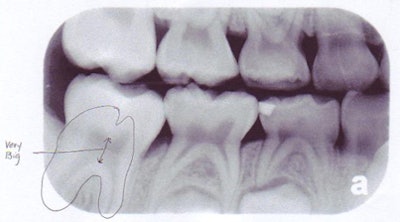 |
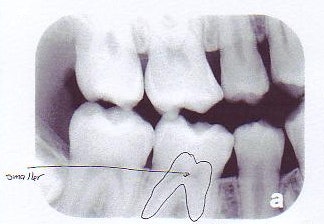 |
| Left, bitewing shows the large pulp typical of a 9-year-old. Right, bitewing of a 16-year-old shows a smaller pulp. | |
So if Deng is younger than 14, a panoramic x-ray would show with 95% certainty that she was younger than 16 and ineligible to participate in the Olympics. But is 95% certainty enough?
"Not for the Olympics or the immigration service," argued Allan Farman, B.D.S., M.B.A., Ph.D., D.Sc., a professor of radiology at the University of Louisville. "There's too much variability. Even with a 9-year-old."
As for Deng's apparently missing teeth, he pointed out that a few individuals never get lateral teeth at all.
While Immigration and Customs Enforcement might accept dentition as definitive proof, this "an abuse of radiography," according to Dr. Farman. Developmental charts should be used by dentists in planning treatment and by anthropologists in drawing conclusions about whole populations, but not for determining the age of individuals, he said.
And even Dr. Senn agreed that current methods of estimating a person's age are "not accurate enough." So he and other researchers are working on other methods. One approach, already in use, is to compare x-rays of teeth with x-rays of wrist bones. Estimating age with wrist bone development is about as accurate as using dentition, but the two can corroborate each other, according to Dr. Senn.
Another approach is to look at the lines (or striae) of Retzius. These lines, visible in the cross section of an individual tooth, show deposits of layers of enamel on a roughly annual basis, analogous to tree rings. But few Olympic athletes are likely to donate a tooth for the purpose of determining their age.
Finally, Dr. Senn and colleagues are looking into patterns by which aspartic acid within teeth converts from one isomer to another on a regular basis. Currently, measuring these isomers requires a dentin sample, but Dr. Senn hopes to use etchants to obtain samples noninvasively.
That approach remains in the future, though. And with the IOC apparently satisfied by the documents provided by all the gymnasts participating in the 2008 Olympics, dentists will have to remain on the sidelines, speculating like everyone else.




